
Here's What the #1 Rental on Airbnb Looks Like
Last Updated: Mar 17, 2025Nestled into the thick redwood and oak forests on the coast of Central California, Kitty Mrache has designed one of the most unique tiny homes that have subsequently become the number one rented property on Airbnb. Known as the mushroom dome cabin, this tiny home blends into the thick forest and gives guests an experience of being surrounded by nature, even though they are only ten minutes from Seacliff State Beach and twenty minutes to downtown Santa Cruz.
Table of Contents
- The Setting
- The Dome
- The House

The unique, cozy construction of the mushroom dome cabin blends in with the beautiful natural surrounding while also offering a construction design that maximizes the energy efficiency of the tiny home.
The Setting
When designing a housing development, one of the first things developers do is clear cut large forested areas to make room for the maximum number of homes that can be fit onto a plot of land. From a sustainability standpoint, the estimated 15 billion trees that we collectively cut down each year creates stress on the environment, exacerbates global warming, and contributes to the loss of topsoil. One report finds that our growing population will need to build at least two billion new homes over the next eighty years, and in the United States, urban areas are growing by about one million acres each year.

The increased demand for new housing development needs to find ways to respect the forested areas that remain, especially in urban and suburban areas. Not only will increased tree cover in our urban and suburban areas offer numerous environmental benefits, but there are also several demonstrated health benefits that come with living near trees.
One recent study published in the journal Scientific Reports finds that “having 10 more trees in a city block, on average, improves health perception in ways comparable to an increase in annual personal income of $10,000 and moving to a neighborhood with $10,000 higher median income or being 7 years younger.” The health benefits of biophilic architectural design depend on allowing the natural world to be a part of the home, and allowing trees to flourish near the site of our homes is obviously a great start.

The Mushroom Dome Cabin is only twenty minutes away from Santa Cruz, California, yet the guests that stay at the cabin routinely admire the feeling of seclusion that comes with being surrounded by oak, Madrone, and Redwood trees. One recent guest remarked that the cabin “is 10 minutes from shops/stores/restaurants, but sitting on the big deck of the mushroom dome you feel like you are truly away from it all."
The ten-acre property where the Mushroom Dome Cabin is located is close to the 10,000-acre forest of Nisene Marks State Park. Kitty and her family raise chickens and goats in the forested setting, and their gardens are home to several species of hummingbirds that are present throughout the year.

Speaking to NBC, Kitty believes that “many guests who come here come to get away from the noise and the crowd…to come and just relax and kickback. They can grill on the barbecue out on the deck, they can take a hike on the hill, pet the goats. We have about 400 hummingbirds here. We call it the hummingbird airport. They just come in at about twenty at a time.” During the summer, the family feeds about 130 ounces of syrup to keep their mini forest buzzing with hummingbirds.
The ten acres plot of land isn’t fenced and guests are encouraged to hike through the woods, learn how to milk the goats that Kitty raises, enjoy the close up sights of hummingbirds eating at the numerous feeders placed near the cabin, or make their way to the ocean whose waves can be heard on a still night.

“The most common response we get from people when they write reviews is how they were able to unwind, able to sleep soundly, and that it was an incredible and rejuvenating experience to stay here,” Kitty relates.
The Dome
The mushroom dome cabin is considered to be semi-rustic, though it is able to be inhabited throughout the year. The main bedroom is located in a beautiful lofted area under a geodesic dome (the "mushroom cap"). Geodesic domes were popularized by Buckminster Fuller and are built with short struts following geodesic lines and forming an open framework of triangles or polygons.

These types of domes (think the Epcot Center at Disney World) are known to be much stronger than typical rectangular structures, and no internal supports are needed due to the fact that the triangular structure evenly distributes the weight throughout the entire structure. Dome homes have also been known to withstand hurricanes and even tornadoes because of the extra element of strength that they offer, thus making them a great option for resilient homes located in vulnerable climactic areas.

Geodesic domes are also known to increase the energy efficiency of a home. Greenhouses are often built as geodesic domes because the domed shape of the roof has up to 40 percent less surface area for the corresponding floor space than a regular rectangular roof. This also allows for improved air circulation over rectangular structures.
“A lot of people have fantasies about staying in a dome," Kitty mentions. “A geodesic dome has this unique quality where you can whisper on one side of it and the sound can travel to the other side.”
Tobias Roberts
Tobias runs an agroecology farm and a natural building collective in the mountains of El Salvador. He specializes in earthen construction methods and uses permaculture design methods to integrate structures into the sustainability of the landscape.












